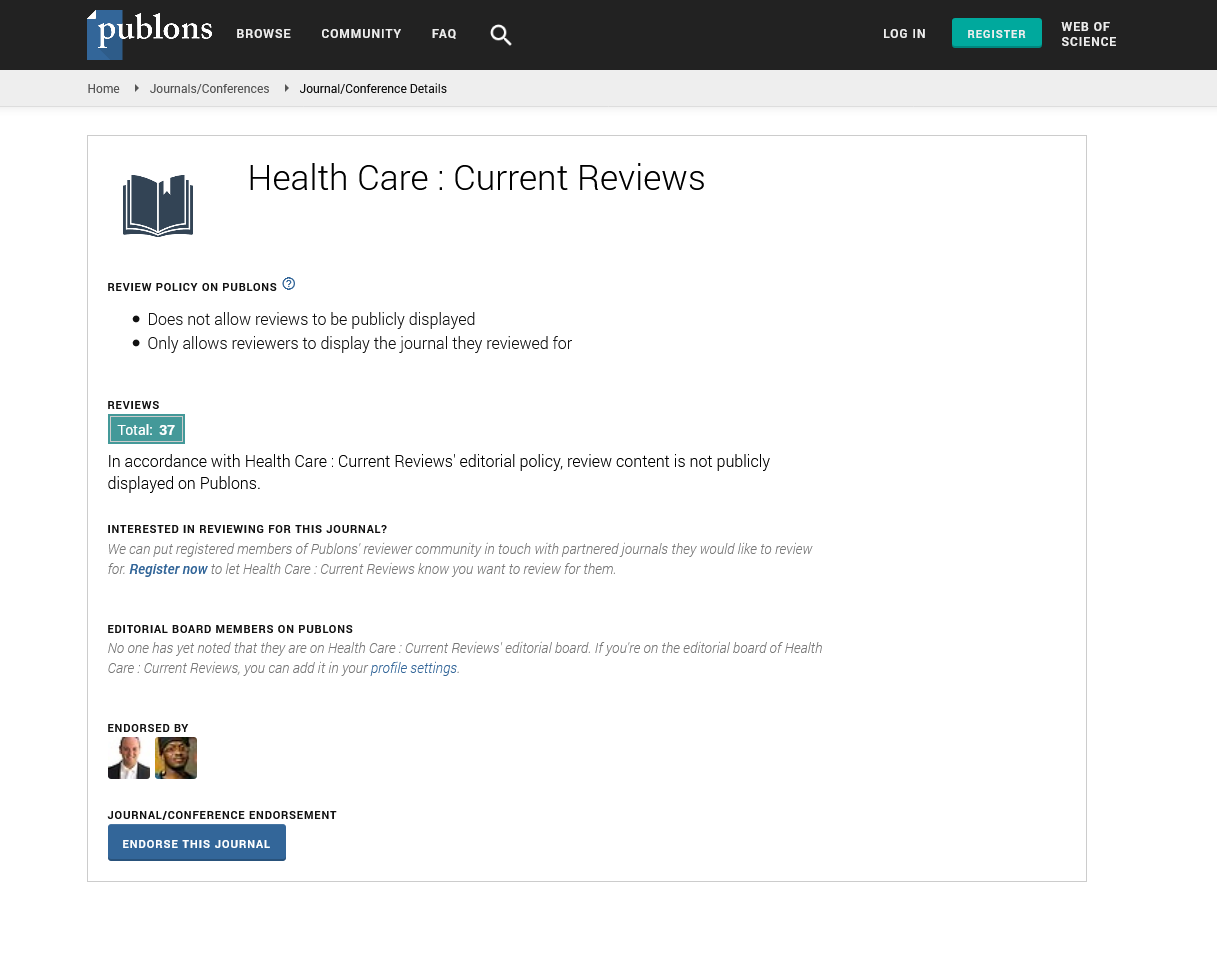Indexed In
- Open J Gate
- Academic Keys
- RefSeek
- Hamdard University
- EBSCO A-Z
- Publons
- Geneva Foundation for Medical Education and Research
- Google Scholar
Useful Links
Share This Page
Journal Flyer

Open Access Journals
- Agri and Aquaculture
- Biochemistry
- Bioinformatics & Systems Biology
- Business & Management
- Chemistry
- Clinical Sciences
- Engineering
- Food & Nutrition
- General Science
- Genetics & Molecular Biology
- Immunology & Microbiology
- Medical Sciences
- Neuroscience & Psychology
- Nursing & Health Care
- Pharmaceutical Sciences
Commentry - (2025) Volume 13, Issue 1
AI-Driven Diagnostics: Revolutionizing Early Disease Detection
Felix Schneider*Received: 26-Feb-2025, Manuscript No. HCCR-25-28737; Editor assigned: 28-Feb-2025, Pre QC No. HCCR-25-28737 (PQ); Reviewed: 14-Mar-2025, QC No. HCCR-25-28737; Revised: 21-Mar-2025, Manuscript No. HCCR-25-28737 (R); Published: 28-Mar-2025, DOI: 10.35248/2375-4273.25.13.429
Description
Artificial intelligence is gradually changing the way healthcare professionals detect diseases in their earliest stages. By analyzing vast amounts of medical data quickly and accurately, AI systems can identify patterns that might be difficult for even experienced practitioners to notice. This improvement in early detection can lead to quicker decisions, potentially reducing complications and improving outcomes for patients [1].
Medical imaging is one of the areas where AI has shown considerable value. Whether reviewing X-rays, MRIs, or CT scans, these systems can highlight areas of concern with impressive speed. In some cases, they may recognize abnormalities before symptoms begin to appear, giving physicians a head start in managing a patient’s care [2]. By reducing the time required to reach a diagnosis, these tools can also help free up professionals to focus on treatment planning and communication with patients.
Beyond imaging, AI is also being used in laboratory diagnostics. From blood test results to genetic screenings, it can sort through thousands of data points in seconds. This not only helps in identifying potential conditions sooner but also allows for more accurate risk assessments. A patient with no visible symptoms might still show biological markers that point to future health concerns. When flagged early, healthcare providers can take preventive steps that might not have been considered otherwise [3].
The rise of electronic health records has also played a role in supporting AI-driven diagnostics. With patient data stored digitally, AI tools can review full medical histories, comparing past reports with current findings. This creates a clearer picture of a person’s health over time and allows for more informed conclusions. It’s especially helpful for chronic conditions, where small changes may indicate bigger issues developing beneath the surface [4].
In regions where access to medical specialists is limited, AI can offer significant support. A rural clinic, for example, may not have an on-site radiologist or pathologist. AI tools can serve as a first line of analysis, giving local doctors a reliable starting point [5]. While human expertise remains important, having this technology available increases confidence and provides reassurance in places where medical resources are stretched thin.
These technologies are also making a difference in the detection of diseases that rely heavily on early intervention. Conditions like cancer, diabetes and cardiovascular disorders benefit greatly from being caught before they progress. AI tools, when integrated into screening programs, can increase detection rates and lower the number of missed cases. This can make treatment less invasive and more manageable for patients, reducing the overall cost and stress associated with long-term care [6].
While AI tools are becoming more common, their effectiveness depends on the quality of the data they receive. Clean, well-organized and diverse data helps improve their performance and accuracy. For this reason, collaboration among hospitals, researchers and technology developers is essential. Together, they can build systems that work across different populations, increasing fairness and reducing errors that might arise from incomplete or biased data sets [7].
Ethical considerations also play a role in how AI is used in healthcare. Patients must be informed about how their data is used and there should be clear rules around consent, privacy and accountability. Ensuring that these tools are developed responsibly helps build trust among users and healthcare providers alike [8].
AI will never completely replace human judgment, nor is that the goal. Its function is to assist and enhance decision-making. In many ways, it acts like a second pair of eyes—offering speed, consistency and support in environments where decisions often need to be made quickly [9]. The combination of human experience and machine learning can create a more effective and efficient healthcare system.
The rise of AI-driven diagnostics signals a shift toward earlier, more proactive approaches to medical care. With continued refinement and cooperation across sectors, these tools will likely become an everyday part of the clinical process. As they continue to evolve, their presence in hospitals, clinics and even remote care settings will grow, reshaping how diseases are detected and how patients experience healthcare from the very beginning of their medical journey [10].
References
- Gupta R, Kumari S, Senapati A, Ambasta RK, Kumar P. New era of artificial intelligence and machine learning-based detection, diagnosis, and therapeutics in Parkinson’s disease. Ageing Res Rev. 2023:102013.
[Crossref] [Google Scholar] [PubMed]
- Jiang Y, Zhou K, Sun Z, Wang H, Xie J, Zhang T, et al. Non-invasive tumor microenvironment evaluation and treatment response prediction in gastric cancer using deep learning radiomics. Cell Rep Med. 2023;4(8).
[Crossref] [Google Scholar] [PubMed]
- Reddy A, Reddy RP, Roghani AK, Garcia RI, Khemka S, Pattoor V, et al. Artificial intelligence in Parkinson's disease: Early detection and diagnostic advancements. Ageing Res Rev. 2024:102410.
[Crossref] [Google Scholar] [PubMed]
- Giannakopoulou KM, Roussaki I, Demestichas K. Internet of things technologies and machine learning methods for Parkinson’s disease diagnosis, monitoring and management: A systematic review. Sensors. 2022 Feb;22(5):1799.
[Crossref] [Google Scholar] [PubMed]
- Walsh SL, Mackintosh JA, Calandriello L, Silva M, Sverzellati N, Larici AR, et al. Deep learning–based outcome prediction in progressive fibrotic lung disease using high-resolution computed tomography. Am J Respir Crit Care Med. 2022;206(7):883-891.
[Crossref] [Google Scholar] [PubMed]
- Liu XW, Li HL, Ma CY, Shi TY, Wang TY, Yan D, et al. Predicting the role of the human gut microbiome in type 1 diabetes using machine-learning methods. Brief Funct Genomics. 2024:elae004.
[Crossref] [Google Scholar] [PubMed]
- Moro F, Ciancia M, Zace D, Vagni M, Tran HE, Giudice MT, et al. Role of artificial intelligence applied to ultrasound in gynecology oncology: A systematic review. Int J Cancer. 2024;155(10):1832-1845.
[Crossref] [Google Scholar] [PubMed]
- Azimi P, Yazdanian T, Benzel EC, Aghaei HN, Azhari S, Sadeghi S, et al. A review on the use of artificial intelligence in spinal diseases. Asian Spine J. 2020;14(4):543.
[Crossref] [Google Scholar] [PubMed]
- Tangri N, Ferguson TW. Role of artificial intelligence in the diagnosis and management of kidney disease: Applications to chronic kidney disease and acute kidney injury. Curr Opin Nephrol Hypertens. 2022;31(3):283-287.
[Crossref] [Google Scholar] [PubMed]
- Chang Z, Zhan Z, Zhao Z, You Z, Liu Y, Yan Z, et al. Application of artificial intelligence in COVID-19 medical area: A systematic review. J Thorac Dis. 2021;13(12):7034.
[Crossref] [Google Scholar] [PubMed]
Citation: Schneider F (2025). AI-Driven Diagnostics: Revolutionizing Early Disease Detection. Health Care Curr Rev. 13:429.
Copyright: © 2025 Schneider F. This is an open access article distributed under the terms of the Creative Commons Attribution License, which permits unrestricted use, distribution and reproduction in any medium, provided the original author and source are credited.

